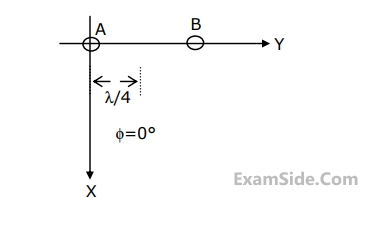1
GATE ECE 2002
Subjective
+5
-0
Consider a linear array of two half - wave dipoles A and B as shown in Fig. The dipoles are $${\lambda \over 4}$$ apart and are excited in such a way that the current on element B lags that on element A by $${90^0}$$ in phase

(a) Obtain the expression for the radiation pattern for E in the XY plane, i.e.,$$\left( {\theta = {{90}^0}} \right)$$.
(b) Sketch the radiation pattern obtained in (a).

2
GATE ECE 1999
Subjective
+5
-0
The average power of an omni-directional antenna varies as the magnitude of cos($$\theta $$) where $$\theta $$ is the azimuthal angle. Calculate the maximum Directive Gain of the antenna and the angles at which it occurs.
3
GATE ECE 1997
Subjective
+5
-0
A dipole antenna has a sin$$\theta $$ radiation pattern where the angle $$\theta $$ is measured from the axis of the dipole. The dipole is vertically located above an ideal ground plane (Fig.). What should be the height of the dipole H in terms of wave length so as to get a null in the radiation pattern at an angle of 450 from the ground plane? Find the direction of maximum radiation also.


4
GATE ECE 1996
Subjective
+5
-0
Two isotropic antennas A and B from an array as shown in Fig. The currents fed to the two antennas are $${{\rm I}_0}\,\angle 0$$ and $${{\rm I}_0}\,\angle \alpha $$ respectively. What should be the value of $$\alpha $$ so that the radiation pattern has a null at $$\theta = {30^ \circ }$$. Find the direction of the maximum radiation for that value of $$\alpha $$ and draw the radiation pattern. ($$\lambda \,\,$$ is the wavelength of operation)


Questions Asked from Marks 5
GATE ECE Subjects
Signals and Systems
Network Theory
Control Systems
Digital Circuits
General Aptitude
Electronic Devices and VLSI
Analog Circuits
Engineering Mathematics
Microprocessors
Communications
Electromagnetics